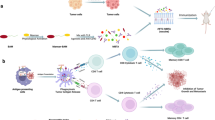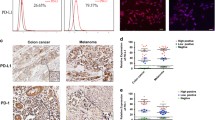Abstract
Metastatic breast cancer is an important contributor to morbidity and mortality. Hence, new therapies are needed that target breast cancer metastases. Here, we focus on Mage-b as a possible vaccine target to prevent the development of breast cancer metastases, through activation of Mage-b-specific cytotoxic T lymphocytes (CTL). The syngeneic cell line 4T1, highly expressing Mage-b, was used as a pre-clinical metastatic mouse breast tumor model. BALB/c mice received three preventive intraperitoneal immunizations with Mage-b DNA vaccine mixed with plasmid DNA, secreting granulocyte–macrophage colony stimulating factor (GM-CSF). In addition, antigen-presenting cells were more efficiently recruited to the peritoneal cavity by the injection of thioglycollate broth (TGB), prior to each immunization. Immunization with Mage-b/GM-CSF/TGB significantly reduced the number of metastases by 67% compared to the saline/GM-CSF/TGB and by 69% compared to the vector control/GM-CSF/TGB. Also, tumor growth was significantly reduced by 45% in mice vaccinated with Mage-b/GM-CSF/TGB compared to the saline/GM-CSF/TGB and by 47% compared to the control vector/GM-CSF/TGB group. In vivo, the number of CD8 T cells significantly increased in the primary tumors and metastases of mice vaccinated with Mage-b/GM-CSF/TGB compared to the saline/GM-CSF/TGB and the control vector/GM-CSF/TGB group, while the number of CD4 T cells significantly decreased. The combination of Mage-b, GM-CSF and TGB did not only induce significantly higher levels of IFNγ in the lymph nodes of vaccinated compared to control mice, but also induced significantly higher expression levels of Fas-ligand (FasL) in the primary tumors (expressing Fas protein constitutively), compared to the control mice. Whether the interaction between Fas and FasL may have contributed to the smaller tumors needs to be further analyzed.






Similar content being viewed by others
References
Althuis MD, Dozier JM, Anderson WF, Devesa SS, Brinton LA (2005) Global trends in breast cancer incidence and mortality 1973–1997. Int J Epidemiol 34:405–412
Berkowitz N, Gupta S, Silberman G (2000) Estimates of the lifetime direct costs of treatment for metastatic breast cancer. Value Health 3:23–30
Scart H, Cantin J, Levin M (2002) Clinical practice guidelines for the care and treatment of breast cancer: mastectomy or lumpectomy? The choice of operation for clinical stages I and II breast cancer (summary of the 2002 update). CMAJ 167:145–155
Kurtz JE, Dufour P (2002) Strategies for improving quality of life in older patients with metastatic breast cancer. Drugs Aging 19:605–622
Alberg AJ, Singh S (2001) Epidemiology of breast cancer in older women: implications for future health care. Drugs Aging 18:761–762
Pardal R, Clarke MF, Morrison SJ (2003) Applying the principles of stem-cell biology to cancer. Nat Rev Cancer 3:895–902
Park JW, Kwon TK, Kim IH, Sohn SS, Kim CI, Bae OS, Lee KS, Lee KD, Lee CS, Chang HK, Choe BK, Ahn SY, Jeon CH (2002) A new strategy for the diagnosis of MAGE-expressing cancers. J Immunol 79:79–86
Van Baren N, Bonnet MC, Dreno B et al (2005) Tumoral and immunological response after vaccination of melanoma patients with ALVAC virus encoding MAGE antigens recognized by T cells. J Clin Oncol 23:9008–9021
Marchand M, Punt CJ, Aamdal S, Escudier B, Kruit WH, Keilholz U, Hakansson L, van Baren N, Humblet Y, Mulders P, Avril MF, Eggermont AM, Scheibenbogen C, Uiters J, Wanders J, Delire M, Boon T, Stoter G (2003) Immunization of metastatic cancer patients with MAGE-3 protein combined with adjuvant SBAS-2: a clinical report. Eur J Cancer 39:70–77
Lurquin C, Lethe B, De Plaen E, Corbiere PG, Boon T (2005) Contrasting frequencies of antitumor and anti-vaccine T cells in metastases of a melanoma patient vaccinated with a MAGE tumor antigen. JEM 201:249–257
Kruit HJ, van Ojik HH, Brichard VG et al (2005) Phase 1/2 study of subcutaneous and intradermal immunization with a recombinant MAGE-3 protein in patients with detectable metastatic melanoma. Int J Cancer 117:596–604
Thurner B, Haendle I, Roder C et al (1999) Vaccination with Mage-3A1 peptide-pulsed mature monocyte-derived dendritic cells expands specific cytotoxic T cells and induces regression of some metastases in advanced Stage IV melanoma. J Exp Med 190:1169–1178
Sun X, Hodge LM, Jones HP, Tabor L, Semecka JW (2002) Co-expression of granulocyte–macrophage colony-stimulating factor with antigen enhances humoral and tumor immunity after DNA vaccination. Vaccine 20:1466–1474
Okamoto T, Kaneda Y, Yuzuki D, Huang SK, Chi DD, Hoon DS (1997) Induction of antibody response to human antigens by gene therapy using a fusigenic viral liposome vaccine. Gene Ther 4:969–976
Ma JH, Sui YF, Huang YY, Li ZS, Chen GS, Ou P, Song HP, Zhang XM (2005) Heat shock protein 70/MAGE-3 fusion protein vaccine can enhance cellular and humoral immune responses to MAGE-3 in vitro. Cancer Immunol Immunother 54:907–914
Van Pel A, De Plaen E, Duffour MT, Warnier G, Uytttenhove C, Perricaudet M, Boon T (2001) Induction of cytolytic T lymphocytes by immunization of mice with an adenovirus containing a mouse homologue of the human MAGE-A genes. Cancer Immunol Immunother 49:593–602
Eggert AO, Andersen MH, Voigt H, Schrama D, Kampgen E, thor Straten P, Becker JC (2004) Characterization of mouse MAGE-derived H-2Kb-restricted CTL epitopes. Eur J Immunol 34:3285–3290
Sypniewska RK, Hoflack L, Tarango M, Gauntt S, Leal BZ, Reddick RL, Gravekamp C (2005) Prevention of metastases with a Mage-b DNA vaccine in a mouse breast tumor model: potential for breast cancer therapy. Breast Cancer Res Treat 91:19–28
Gravekamp C (2007) Cancer vaccines in old age. Exp Gerontol 42:441–450
Dranoff G, Jaffee E, Lazenby A, Golumbek P, Levitsky H, Brose K, Jackson V, Hamada H, Mulligan RC (1993) Vaccination with irradiated tumor cells engineered to secrete murine granulocyte–macrophage colony-stimulating factor stimulates potent, specific, and long-lasting anti-tumor immunity. Proc Natl Acad Sci USA 15:35–39
Shi Y, Roberts AI, Das J, Xu G, Ren G, Zhang Y, Zhang L, Yuan ZR, Tan HS, Das G, Devadas S (2006) Granulocyte–macrophage-colony-stimulating factor (GM-CSF) and T-cell responses: what we do and don’t know. Cell Res 16:126–33
Yasuda K, Kawano H, Yamane I, Ogawa Y, Yoshinaga T, Nishikawa M, Takakura Y (2004) Restricted cytokine production from mouse peritoneal macrophages in culture in spite of extensive uptake of plasmid DNA. Immunol 111:282–290
Chambers RS, Johnston SA (2003) High-level generation of polyclonal antibodies by genetic immunization. Nat Biotechnol 21:1088–1092
Aslakson CJ, Miller FR (1992) Selective events in the metastatic process defined by analysis of the sequential dissemination of subpopulations of a mouse mammary tumor. Cancer Res 52:1399
Lelekakis M, Moseley JM, Martin TJ et al (1999) A novel orthotopic model of breast cancer metastasis to bone. Clin Exp Metastasis 17:163–170
Rak JW, McEachern D, Miller FR (1992) Sequential alteration of peanut agglutinin binding-glycoprotein expression during progression in murine mammary neoplasia. Br J Cancer 65:641–648
Smith PK, Krohn RI, Hermanson GT, Mallia AK, Gartner FH, Provenzano MD, Fujimoto EK, Goeke NM, Olson BJ, Klenk DC (1985) Measurement of protein using bicinchoninic acid. Anal Biochem 163:279
Reeves FR, Reeves PA (2003) Current protocols in immunology, vol 1. In: Coligan JE, Kruisbeek AM, Margulies DH, Shevach EM, Strober W (eds) Care and handling of laboratory animals. City of University of New York Medical School, Wiley, New York, P1.9.1
Simstein R, Burow M, Parker A, Weldon C, Beckman B (2003. Apoptosis, chemoresistance, and breast cancer: insights from the MCF-7 cell model system. Exp Biol Med 228:995–1003
Gajewski TF, Meng Y, Harlin H (2006) Immune suppression in tumor microenvironment. J Immunother 29:233–240
Chen ML, Pittet MJ, Gorelik L, Flavell RA, Weissleder R, von Boehmer H, Khazaie K (2005) Regulatory T cells suppress tumor-specific CD8 T cell cytotoxicity through TGF-β signals in vivo. PNAS 102:419–424
Park SJ, Nakgawa T, Kitamura H, Atsumi T, Kamon H, Sawa SI, Kamimura D, Ueda N, Iwakura Y, Ishihara K, Murakami M, Hirano T (2004) IL-6 regulates in vivo dendritic cell differentiation through STAT3 activation. J Immunol 173:3844–3854
Chen W, Jin W, Hardegen N, Lei KJ, Li L et al (2003) Conversion of peripheral CD4+CD25+ naïve T cells to CD4+CD25+ regulatory T cells by TGF-beta induction of transcription factor Foxp3. J Exp Med 198:1875–1886
Acknowledgments
Authors gratefully acknowledge Rita Busuttil, Ana-Maria Garcia, Shanique Leonard, and Karl Rodriguez, for their excellent technical assistance in the mouse studies. This work was supported by The American Federation for Aging Research (AFAR) A000106 grant, and by NIA grant 1RO1 AG023096-01.
Author information
Authors and Affiliations
Corresponding author
Rights and permissions
About this article
Cite this article
Gravekamp, C., Leal, B., Denny, A. et al. In vivo responses to vaccination with Mage-b, GM-CSF and thioglycollate in a highly metastatic mouse breast tumor model, 4T1. Cancer Immunol Immunother 57, 1067–1077 (2008). https://doi.org/10.1007/s00262-007-0438-5
Received:
Accepted:
Published:
Issue Date:
DOI: https://doi.org/10.1007/s00262-007-0438-5




